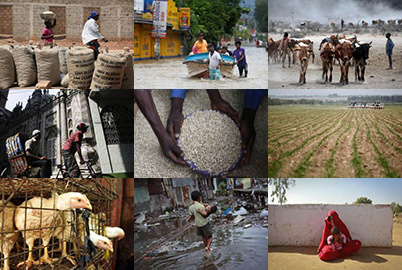* Any views expressed in this opinion piece are those of the author and not of Thomson Reuters Foundation.
AlertNet has had a facelift. Tell us what you think and suggest more improvements.
A message from the editor
For the curious or the nostalgic, an online archive called the Wayback Machine lets you type in a favourite web address, click "take me back" and chuckle at a site's past incarnations when the internet was in its infancy.
Like insects preserved in amber, the screenshots hold clues to the times. AlertNet, which started life in 1997 as a tool for aid workers to share operationally sensitive information, is no exception. In the site's earliest version, the old pinwheel logo of the Reuter Foundation (back then there was no "s" in Reuters, let alone a "Thomson") abuts a melodramatic lightning bolt.
Web design clearly had a way to go.
Some 13 years later, AlertNet has undergone its latest change of clothes. Future nostalgists may find reason to chuckle - while some present users may also have their peeves - but to my mind, the new-look AlertNet contains a lot to cheer about. Greater visual impact, better navigation and smarter aggregation of content are among the improvements.
These changes were based on audience feedback and user testing. That doesn't mean we've got everything right - nor does it mean we've finished the job. Expect more functionality in coming months. In the meantime, we'd love to hear your thoughts on the new site. Love it or hate it, have your say by commenting below.
But first, 10 things to know about the new AlertNet:
- The new design underlines our commitment to multimedia. In the age of YouTube, Flip cameras and audio slideshows, our goal is to bring humanitarian issues to life through striking visuals and new forms of storytelling.
- Findability is our priority. Many users complained that the old AlertNet had a lot of great content, but it was hard to get your hands on it. Now no piece of content should be more than three clicks away. We hope navigation will feel more intuitive.
- Our new Crisis Centre puts news, background information and a range of resources at your fingertips. "Quick find" tools help you track down crisis briefings quickly, or you can explore humanitarian themes by topic.
- AlertNet's 450-plus NGO partners now have a dedicated members area, giving them special tools and greater visibility. News feeds from member organisations are also much more prominent across the site.
- We've overhauled our blogs, improving our blogging engine and introducing conversation streams such as The Debating Chamber, Aid Worker Diaries and TechnoTalk. Expect more in the coming weeks and months.
- Our revamped Climate Change section - now a site in itself - spotlights the human impact of global warming through our ever-growing network of grassroots contributors. We take you to the frontlines of climate change with stories, blogs, videos and resources you won't find anywhere else.
- AlertNet's new country profiles combine humanitarian snapshots with up-to-date information on government, economy and legal systems, along with countless facts and figures.
- Our interactive number cruncher lets you interrogate our expanded statistics database to create customised charts or view indicators on a map. Dozens of indicators cover everything from demographics and economics to health, communications, aid flows and numbers of natural disasters.
- A new and improved jobs section makes finding the perfect job in the aid sector even easier. View openings on a map or subscribe to job alerts by email.
- And finally, we've changed our strapline.
For more than a decade, AlertNet’s slogan was "Alerting humanitarians to emergencies". That choice of wording reflected the site's early mission to help relief workers better respond to crises - by giving them early warning and helping them coordinate their activities.
While those goals remain, we recognise that our audience has now moved beyond relief professionals. We also serve donors, journalists, policymakers, researchers, teachers, students and members of the public who care about what goes on outside their own backyard.
Importantly, we also aim to serve communities caught up in crisis, who are increasingly web-savvy, wired and capable of speaking for themselves. That’s why we've hit upon "The world's humanitarian news site" - a description we feel hints at the inclusiveness we strive for every day.
I hope you enjoy poking around the new site. Don't be shy in telling us what you think.
Our Standards: The Thomson Reuters Trust Principles.

